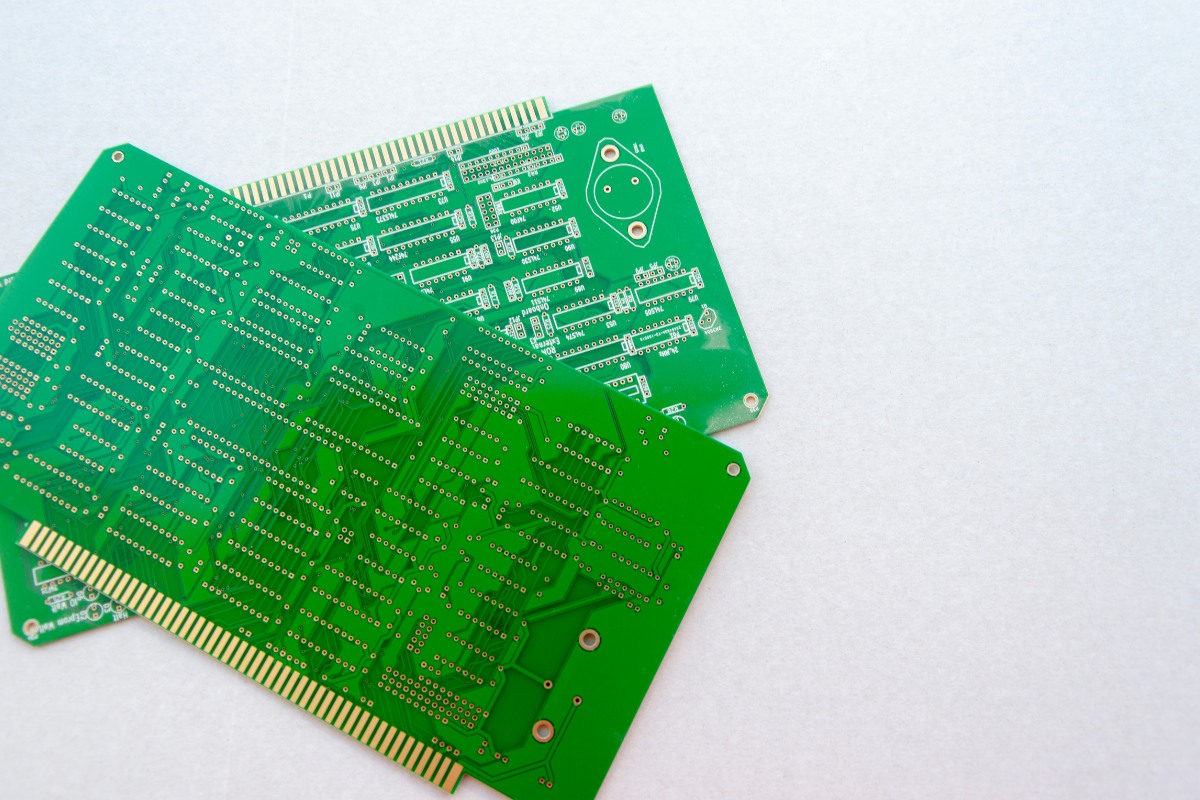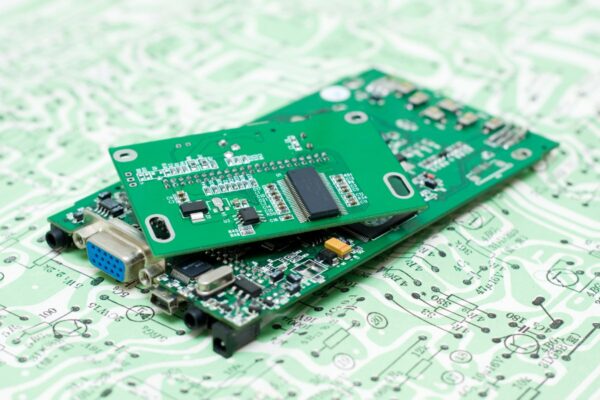Printed Circuit Boards (PCBs) are the backbone of modern electronics, connecting and supporting various components in devices ranging from smartphones to computers. While PCBs come in a variety of colors, the most common and recognizable color is green. This ubiquitous green hue has become synonymous with PCBs, but have you ever wondered why?
In this article, we’ll explore the history and reasons behind the green color of PCBs, delving into the role of solder masks, military influences, visual advantages, technical superiority, and economic factors that have contributed to the enduring legacy of green PCBs.
Understanding Solder Mask – The Green Layer
The green color of PCBs comes not from the substrate itself, but from a protective layer called solder mask. Solder mask, also known as solder resist, is a thin polymer coating applied to the copper traces of a PCB. Its primary functions include:
Protection from Environmental Factors
Solder mask shields the copper traces from oxidation and corrosion, preventing the formation of a non-conductive layer that could impede electrical signals. It also safeguards the PCB from moisture and dust contamination, which could lead to short circuits or other malfunctions.
Electrical Insulation
By covering the spaces between copper traces, solder mask prevents accidental short circuits that could occur if conductive materials come into contact with exposed traces.
Solder Flow Control
During the soldering process, solder mask helps control the flow of molten solder, ensuring that it only adheres to the exposed pads and doesn’t bridge adjacent traces.
The solder mask application process involves coating the PCB with a layer of photosensitive polymer, which is then exposed to UV light through a photomask. The unexposed areas are washed away, leaving the desired pattern of solder mask on the board. Finally, the PCB undergoes a curing process to harden the solder mask and enhance its protective properties.
How Green Became the Standard
The prevalence of green PCBs can be traced back to the early days of PCB development, particularly in the United States military. During the 1950s, the U.S. military conducted extensive research on PCB colors and their performance in various adverse conditions. Their findings indicated that green was the most effective and reliable color for PCBs in military applications.
As a result, the military established specifications mandating the use of green solder masks for PCBs used in their equipment. Many PCB manufacturers supplying the military also served commercial customers, and due to the large volume of military contracts, these suppliers often had a surplus of green solder mask. Consequently, green became the default color for PCBs in both military and civilian applications, as it was readily available and cost-effective.
The transition from military to civilian use of green PCBs was further facilitated by the fact that most PCBs are hidden inside electronic devices, making their color largely irrelevant to end-users. As green PCBs became more commonplace, the color became an industry standard, even as new solder mask colors became available.
Green’s Impact on Inspection and Assembly
The human eye is particularly sensitive to green light, making it easier to discern details and contrast on a green background. This sensitivity has played a significant role in the continued use of green PCBs, especially in manual inspection and assembly processes.
The high contrast provided by the green solder mask against copper traces and white silkscreen markings reduces eye strain for technicians and assembly line workers who spend long hours examining PCBs. This improved visibility helps in identifying defects, such as solder bridges, cold solder joints, or misaligned components, ensuring higher quality control and fewer assembly errors.
Although automated optical inspection (AOI) systems have largely replaced manual inspection in modern PCB manufacturing, the legacy of green PCBs persists. Many AOI systems are calibrated and optimized for green PCBs, as the color provides a consistent and reliable background for automated visual analysis.
The Advantages of Green Solder Mask
Beyond its visual benefits, green solder mask has proven to be technically superior to other colors in several aspects. One factor is its ability to create smaller solder mask dams, which are the spaces between exposed copper pads and the surrounding solder mask.
Smaller solder mask dams allow for finer pitch components and higher density PCB designs. Green solder mask can reliably achieve dam widths as small as 0.1mm (4 mil), while other colors, such as red and blue, typically have a minimum dam width of 0.12mm (4.7 mil). Black and white solder masks are even more limited, with minimum dam widths of 0.15mm (6 mil).
The superior performance of green solder mask in creating smaller dams is attributed to its optimal UV light absorption properties during the exposure process. This technical advantage has contributed to the continued dominance of green PCBs in the electronics industry, particularly in applications requiring high-density component placement.
The Cost-Effectiveness of Green PCBs
The widespread adoption of green PCBs has led to economies of scale in PCB manufacturing. As green solder mask became the industry standard, PCB manufacturers optimized their processes and supply chains around this color, resulting in lower production costs compared to other colors.
The cost-effectiveness of green PCBs is further enhanced by the availability and affordability of green solder mask materials. The pigments used in green solder masks are more readily available and less expensive than those required for other colors, contributing to the lower overall cost of green PCBs.
Producing non-green PCBs often involves additional challenges and expenses. Switching solder mask colors requires manufacturers to clean their equipment, adjust their processes, and potentially maintain separate production lines for different colors. These factors can increase production time, reduce efficiency, and ultimately drive up the cost of non-green PCBs.
Moreover, the standardization of green PCBs has led to improved panelization and production efficiency. PCB manufacturers can optimize their panel layouts and manufacturing processes based on the consistent use of green solder mask, resulting in higher yields and lower costs.
Other PCB Colors and Their Applications
While green remains the most common PCB color, advancements in solder mask technology have led to the availability of a wider range of colors, each with its own unique properties and applications. Some of the most notable alternative PCB colors include:
Blue
Blue PCBs offer excellent contrast against white silkscreen markings, making them a popular choice for applications requiring extensive labeling or text. They are often used in LCD displays and other visual interfaces.
Red
Red PCBs provide good visibility and contrast, similar to green boards. They are sometimes used for prototyping or in applications where a distinct visual appearance is desired.
Black
Black PCBs offer a sleek and modern look, but their low contrast can make inspection and assembly more challenging. They are often used in high-end consumer electronics or applications where aesthetics are a priority.
White
White PCBs are relatively uncommon due to their poor contrast and visibility. However, they are sometimes used in LED lighting applications or as a stylistic choice in certain products.
The choice of PCB color is often influenced by a combination of aesthetic considerations, such as brand identity or product differentiation, and functional requirements, like thermal management or industry-specific standards. As PCB technology continues to evolve, the range of available colors and their associated properties may expand, offering designers and engineers more options to suit their specific needs.
Environmental Considerations
There are growing concerns about the environmental impact of certain materials used in their production. Traditional green solder masks often contain halogenated compounds, such as brominated or chlorinated flame retardants, which can have negative environmental and health consequences.
When exposed to high temperatures, such as during the soldering process or in the event of a fire, these halogenated compounds can release toxic fumes, including dioxins and furans. These substances can pose risks to human health and the environment, particularly in the context of electronic waste disposal.
In response to these concerns, the electronics industry has been moving towards the adoption of halogen-free solder masks. These alternative materials aim to reduce the environmental impact of PCBs while maintaining the necessary performance and reliability standards.
Halogen-free solder masks are formulated using alternative flame retardants and pigments that do not contain bromine or chlorine. While these materials may have slightly different properties compared to traditional green solder masks, they offer a more environmentally friendly option for PCB manufacturing.
As environmental regulations and consumer awareness continue to evolve, the use of halogen-free solder masks and other eco-friendly PCB materials is likely to become more widespread, driving further innovation in the industry.
The Enduring Legacy of Green PCBs
The world of PCBs is not static, and the industry continues to balance tradition with innovation. As new technologies and materials emerge, the range of available PCB colors and their associated properties may expand, offering designers and engineers more options to suit their specific needs.
When choosing a PCB color, engineers and designers must consider a variety of factors, including visual contrast, component density, thermal management, environmental impact, and overall cost. While green remains the default choice for many applications, the increasing availability of alternative colors and halogen-free materials provides opportunities for customization and environmental responsibility.
As we look to the future, it is clear that the legacy of green PCBs will continue to shape the electronics industry. Whether through the continued use of traditional green solder masks or the adoption of new, eco-friendly alternatives, the color green will forever be associated with the ingenuity, reliability, and innovation that have driven the growth of electronic technology.
So the next time you glimpse a green PCB, take a moment to appreciate the rich history and the countless factors that have contributed to its enduring presence in our electronic world.






